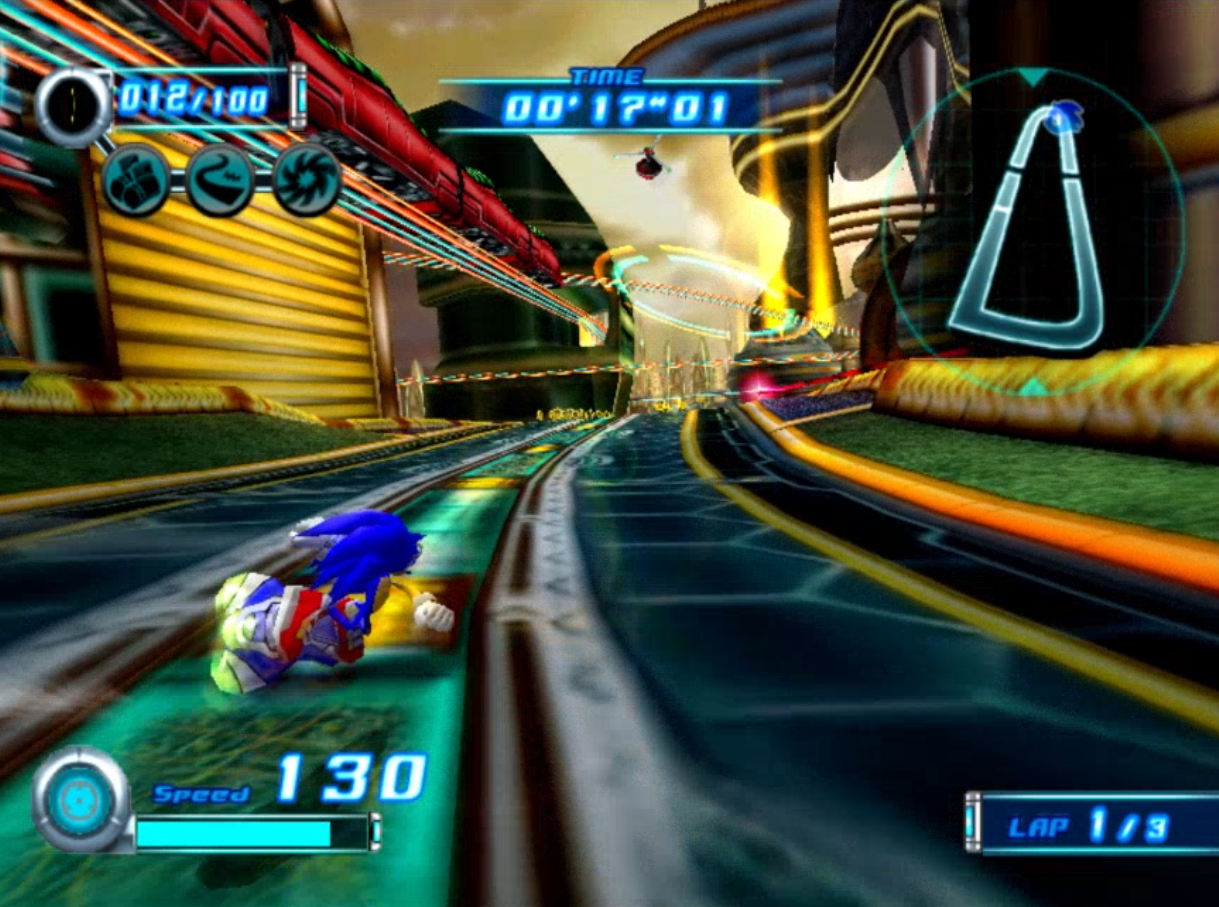

Sonic Riders Zero Gravity is a game that I don't have that many memories of besides some of the presentation aspects that easily stand out in that game, but I really don't remember getting to play it too much on the Wii to have any young memories with it, and years ago when I was already grown up, I think I may have tried to revisit it but forget soon about it due to that one aspect of it that is to the liking of Riders 1 detractors - or the other way around, to the dismay of Riders 1 enjoyers.
Long story short, Sonic Riders and Sonic Riders Zero Gravity have a lot of differences, down to the basics seen in the first game, and is a more streamlined game to get into compared to Riders.
This is something I'll touch on when I talk about the core gameplay, which interestingly enough I'm actually feeling more positive about than the last time I gave it a shot, but I'd like to first address the cyberpunk elephant in the room that would be the first impressions at a visual and sound perspective of this game.
Surprising that they never referenced this game so far, eh?
While Riders was already set in a sort of futuristic enviroment with the hoverboards and some of the tracks, Zero Gravity really infuses the presentation with an even more distinct vibe to the menus, music and stages, all of which alongside the title of the game send home how much more technologically advanced the world in this one is.
If there's one thing that Zero Gravity misses out stylistically from the original would be the 2D animated intro and the custom hand drawn character portraits on the select screen, and while the very few CGI cutscenes in the game are quite well done considering the time they were made [probably the same studio behind the Sonic Unleashed CGI cutscenes], the renders in the character select screen look fairly cheap.
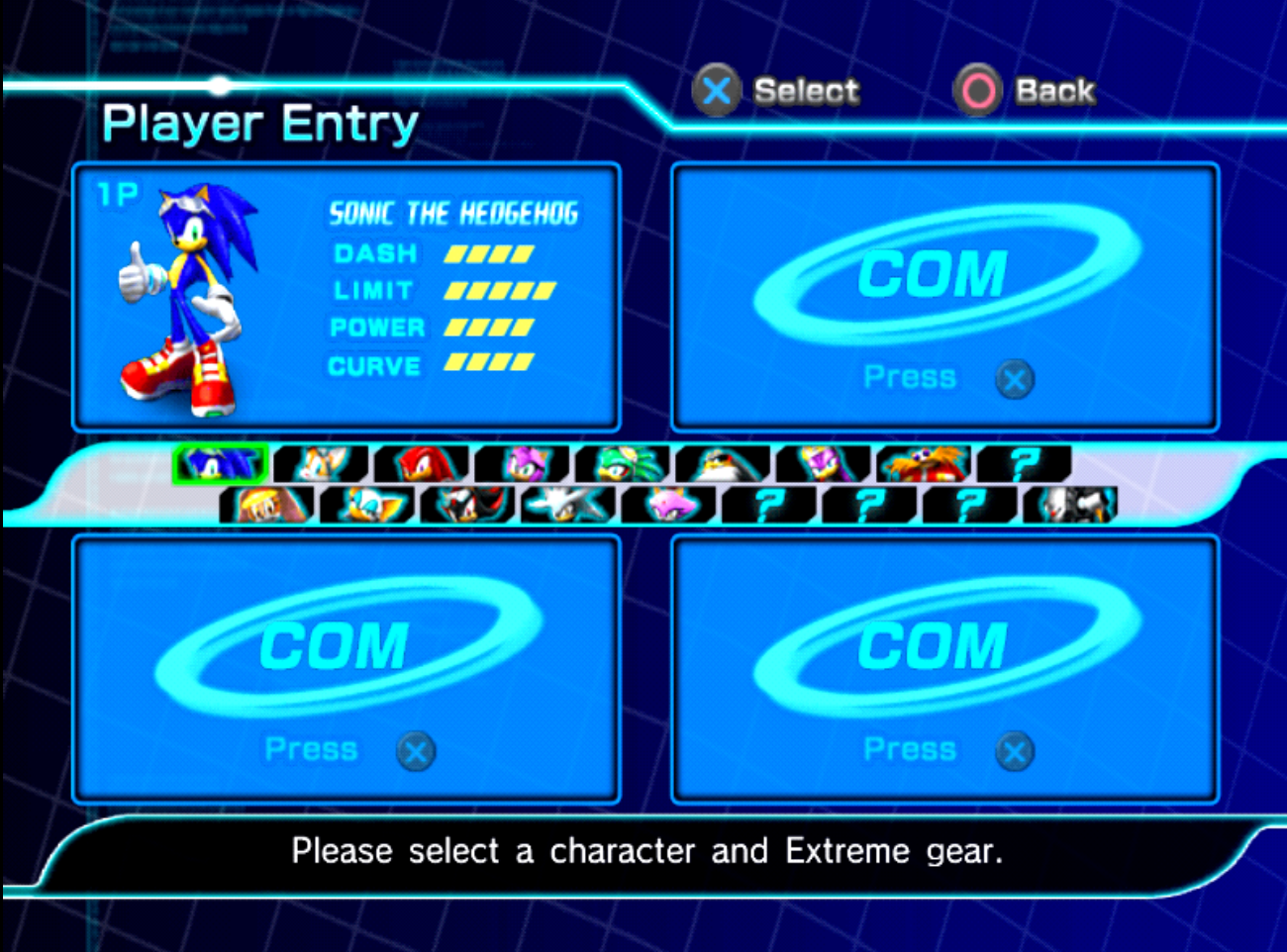
But hey, the menus are otherwise fairly slick with the colors and electric-like theming, as well as the music in those menus being really good, thanks to those being instrumental variants of what would be the two main themes of the game...but you'll only hear the full versions with vocals in-game whenever you complete the two story modes and their staff rolls, getting Un-gravitify [the main menu theme] with Heroes Story, and getting Catch Me If You Can [the Extra and Options theme] with Babylon Story.
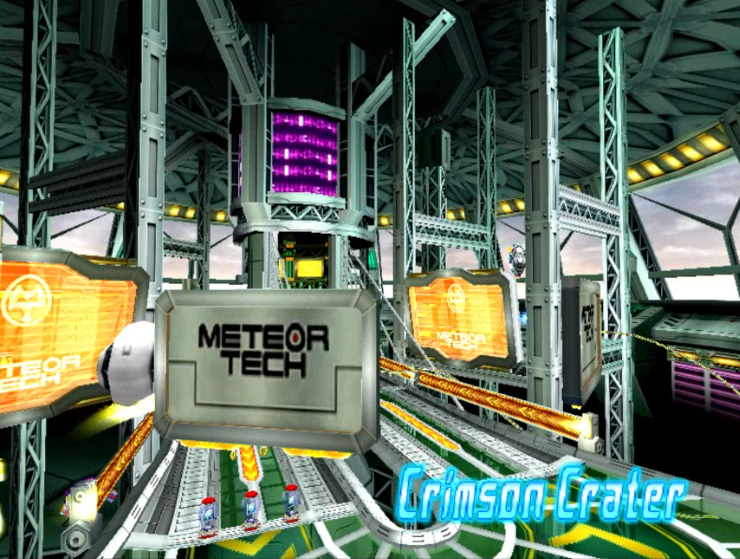
Thankfully, for what's good looking enviroments and music, all the stages deliver that in spades, whether going through the futuristic areas of Megalo Station and MeteoTech Premises, the more natural looking with persistent hints of technology at Botanic Kingdom and Gigan Rocks, and the contrast that the water themed Aquatic Capital and the big tower where the Crimson Crater track is set provide in variety. That's not to mention the 80s and 90s Boulevard tracks that are a throwback to a more grounded city with classic SEGA game advertisements, but those are only unlocked when you complete the Babylon Story and are relegated to extra tracks outside of the Grand Prix mode.
Forget drifts, just un-gravitify through turns
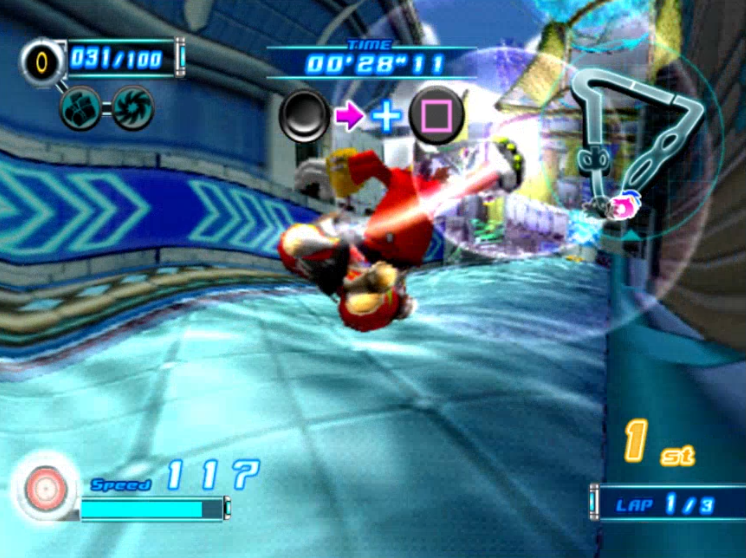
The first Sonic Riders was about managing your Air tank, used for boosts and long drifts, since running out of it would leave you running on foot and slower than the rest, which forced you to be mindful about how much Air you wasted besides any track sections where you need to do so, as well as making sure to hit good trick jumps to refill more air.
Zero Gravity gives you GP instead, which while doesn't deplete gradually and doesn't leave you at a weaker state if depleted, is still important to keep track of, as it is used for the two new techniques introduced in this game, one of which is meant to replace the old drift.
The Gravity Control technique, which is used with Square in the PS2 version and the B button in the Wii version with a GC controller, basically has you float in place, slightly sliding ahead of where you were going, in order to turn over a sharp turn and release the button to then burst forward into the direction you turned at.
The Gravity Dive is technically the boost replacement in this game, but rather than being something meant to be used freely at any time for a quick speed boost, here it is a BIG boost with a similar delay to the Gravity Control that will propel you mid-air, allowing you to hit any big floating objects to increase the GP gauge that's actively spent while using this.
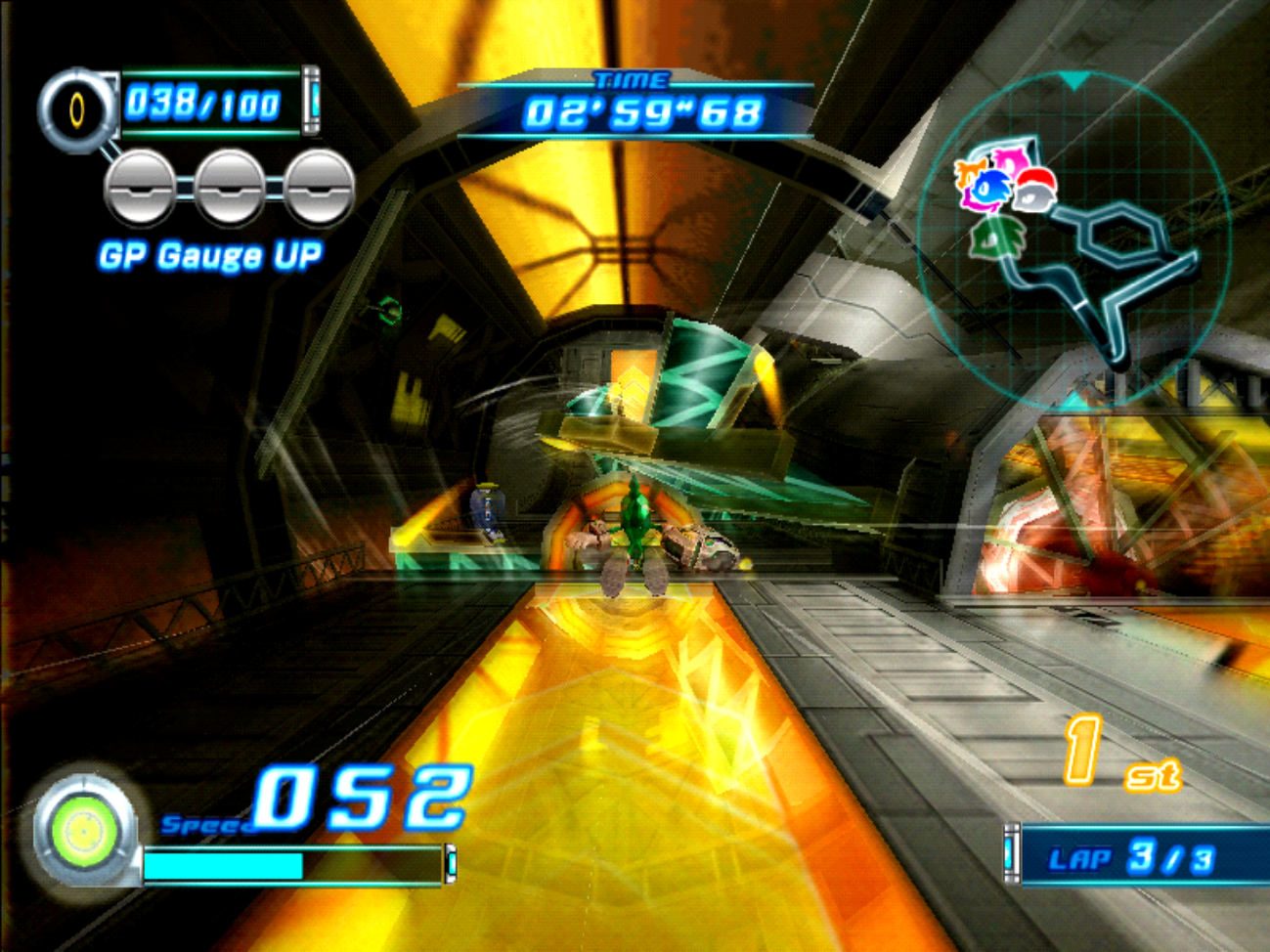
...And if you go through the game tutorial, you'll see how it walks you into using it for the sections it was made for, as not only these are notably long straights that would take you a fair bit more to travel without it, but also are the only spot in a track where the floating objects will spawn for you to take advantage of and extend your boost.
But I know that the elephant in the room needs to be addressed, and its the one that has made the game be so divisive if not mostly mediocre in reception, not just back in the day but even to this day.
Simplified for the best? Oversimplified for the worst?
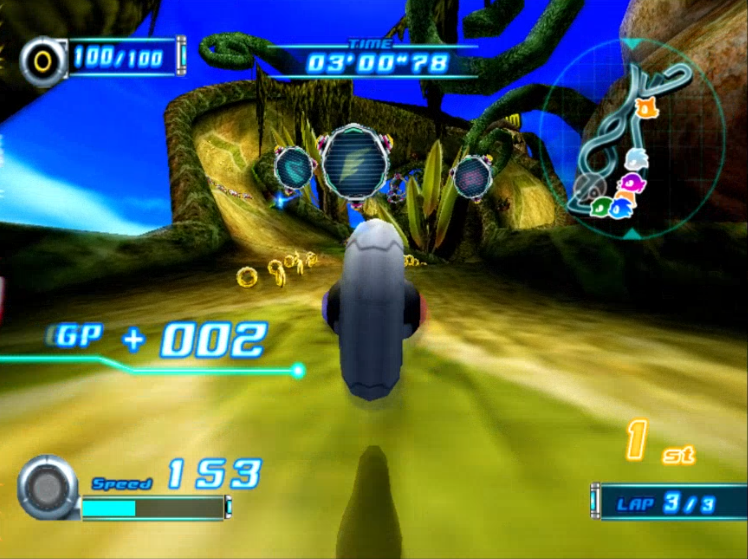
On a vacuum, it is interesting how there's stuff to wrap around your head the first time, like the gear change stuff that isn't explained through the tutorial, but while the streamlined controls have made it stick better with some than the original Riders, most fans of the first game feel like ZG is a big downgrade because of how it oversimplified what made the tick.
And if there's something that does show more side effects of the need for motion controls for the Wii version, that would be the track design.
You could say it makes sense that the beginner tracks constitute mostly of long straights and few turns, but you will likely notice how most tracks have quite a fair amount of straights [not counting the one intended for Gravity Dive] with few turns that need you to Gravity Control through them, making most cool shortcuts being relegated to using a specific gear change to enable a path [Rail Grind, Air Ride, obstacle breaking with Bike], a well timed Gravity Control to go into side paths [Crimson Crater is the one track where its usable to cut time in the main road] or trying to use Gravity Dive in straights outside of the intended area to speed up - at the cost of low grip for turns.
When you think about the game needing to be designed for the Wii controls, you could think of how level design may have been compromised in general compared to the first game, which is a similar case to Super Monkey Ball Banana Blitz, but perhaps what adds to the pace being slow in some tracks than expected is that lack of a non situational or super commital boost like the Gravity Dive is [not only due to the delay but also due to the low grip until you let go], meaning you will mostly be doing turns with the analog stick and engaging with the shorcuts if possible until a sharp turn tells you to Gravity Control or a super long straight tells you to Gravity Dive.
That's if you're playing the PS2 version [which I did] or the Wii version with a Gamecube controller, since otherwise you WILL have to use some form of motion controls if playing with the Wiimote, and for how it explains the need of making tracks less harsh to accomodate for it [again, like Banana Blitz], it certainly doesn't take away neither the possible issues you'd run into playing the game with motion controls, nor the feeling of somewhat empty straights in tracks with a proper controller.
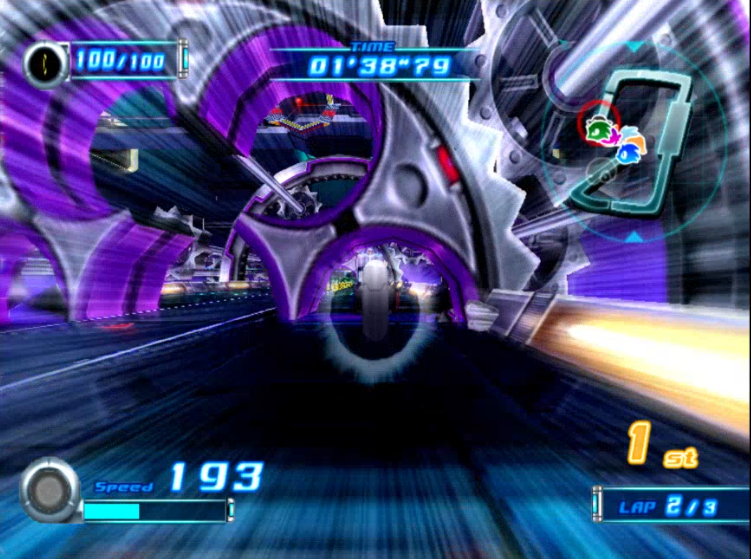
In any case, it is clear that the streamlining of mechanics and track design would have not only been due to the mandatory Wii version but also due to the perceived difficulty of Sonic Riders back in the day, since that game had a far more complex set of tracks with a variety of mechanics needed to master them...that you wouldn't know of in full unless you watched the tutorial video or investigated on your own.
A classic case of trying to address a game being too overwhelming at a first glance through a sequel, but the core controls being changed so much that the basics from the first game wouldn't carry over as well as being noticeably easier across the board due to the streamlining forcing it to often live in the shadow of the less forgiving yet far more rewarding original Sonic Riders.
And what are my thoughts on the game overall after saying all of this? A bit mixed...but I'd say more positive than what I may have implied after all of this.
Conclusion

There's some games that seem to be described to hit the homerun on the vibes and presentation more than the gameplay itself, the Jet Set Radio games being a particular example I often hear of this in video essays [more so the first game due to it being jankier than the sequel Jet Set Radio Future] being praised about what the game can show you and let you feel despite the gameplay, and regardless of how you feel like the JSR games fit on that category...I do bring that up because Sonic Riders Zero Gravity HAS to be one such case.
Now, the game DOES have some stuff to do outside of the Story Mode, such as playing the World Grand Prix for six back-to-back tracks whenever you have done both stories, trying to purchase some new Extreme Gears through the shop, trying out the Survival modes, and perhaps the most interesting diversion from the base gameplay, a set of missions per track you can access after the story modes. But whether the simple ride is alluring enough for you to give all of that a shot or not is a different topic [and also whether you are playing with RetroAchievements or a personal checklist of sorts to go through the Survival modes, since they don't usually give you anything for playing them].
I'd definitely say that the game seems to work better when you play it in brief sessions, such as doing one story or grand prix in a sitting, or doing several missions at a sitting - but playing it for too long at once will probably have you get tired out some races taking over 3 minutes due to the game's pace [this was my experience after doing Babylon Story and then trying the first World Grand Prix in one day, since I had to go through all six races after already having done seven races through Babylon Story].
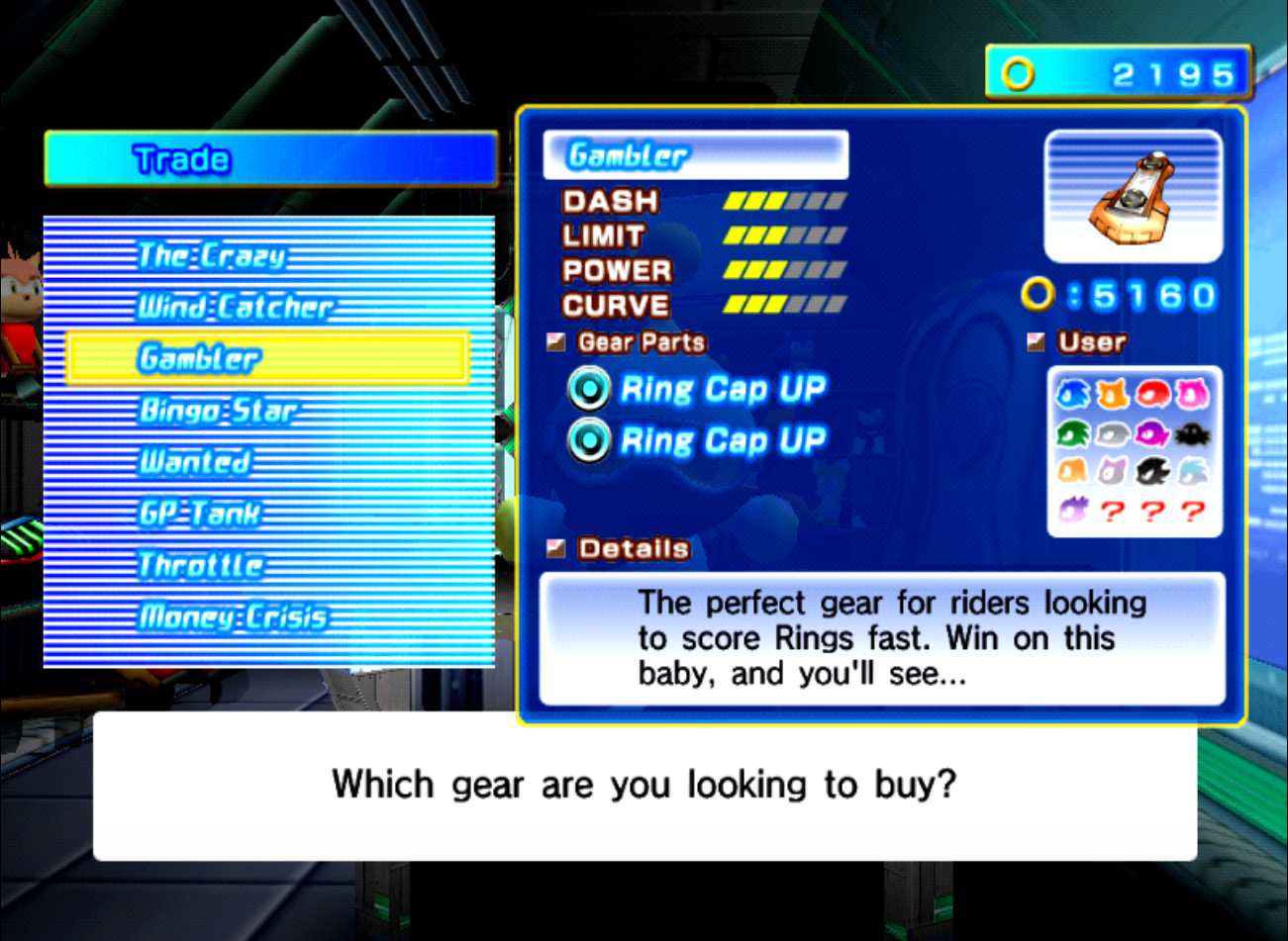
And on the note of completion, the game only lets you keep a maximum of 100 rings with most gears to save for the shop...when almost all Gears can cost from a thousand to nine thousand rings, so yeah, unfortunately it does look like getting all of those HAS to be a grind.
At the end of the day, I don't feel as annoyed with this game as I did with Banana Blitz HD despite also having the same feeling of compromised tracks for a new control scheme, and maybe that's because I didn't do a three hour playthrough of this game like I did BBHD nor ran into some sudden dumb difficulty spikes in any of the levels...But at the same time, there isn't much that the game does to challenge you at all if you are just here to play through the main modes if you are familiar with the tracks and controls.
There's no difficulty options, and unless you are playing with RetroAchievements to have some extra challenges [like getting all Extreme ranks in the track missions, which can offer a fair bit more resistance than the rest of the game, completing races with certain gears and conditions, or the one that stuck out the most to me: Finishing a lap in specific tracks under a set time], you'll probably run out of stuff to do that isn't a pushover...although apparently the CPU races in Free Race are tougher than what the other modes throw at you for some reason, so I'll have to go give that a look.
[A few Free Races later]

...Well, I can see why people some people say that. Still possible to win handily if you can unlock the means to take shortcuts often, but at least achieving that in 80s Boulevard took me a few attempts to not mess up early on.
But this other shot is from doing a Free Race over Crimson Crater - whenever you can get to really cut corners HARD on a track, you'll definitely still do a complete washout over the competition.

So I guess that my final veredict is that the game is...simple. It sure can work for people that want a taste of something that looks like anti-graivty racing or couldn't pick up well the first game, the presentation is strong and there's at least some decently paced tracks with the latter half thanks to shortcuts [aside from Astral Babylon and Mobius Strip which are essentially drag race tracks], but its easy to see why it was a downgrade for most players of the first game when it traded the challenging factor of its mechanics for a far more accessible even if a bit more shallow experience.

Has enough to not feel like the game is babying any beginners if they want to get hooked with this game, while holding back to allow experienced players to take it casually or even try to aim for record laps and times by cutting any corners possible...but if you are someone who's hoping for an absolute balls-to-the-wall racing challenge of mastery like some well known antigravity racers [F-Zero X and GX, Wipeout, BallisticNG, Redout, Distance, Fast RMX] or even the first Sonic Riders could provide, I think you may know by now that you won't really get it here.
Still, I can't say that I didn't get a kick out of trying to crack some fast laps and missions over these tracks after going through the story. It is sure a game that can wear out the impatient much faster if playing for extended amounts of time whenever it has any downtime any time you have to restart a race or mission, but it isn't that bad if you chip away at it on small doses.
Thanks for reading, and see you next time.

Spanish translation with DeepL. All screenshots were captured by myself.
Español

Sonic Riders Zero Gravity es un juego del que no guardo muchos recuerdos, salvo algunos aspectos de la presentación que destacan fácilmente en él, pero realmente no recuerdo haberlo jugado mucho en la Wii como para tener recuerdos de mi infancia con él, y hace años, cuando ya era adulto, creo que intenté volver a jugarlo, pero lo olvidé rápidamente debido a ese aspecto que gusta a los detractores de Riders 1, o al contrario, para consternación de los aficionados a Riders 1.
En resumen, Sonic Riders y Sonic Riders Zero Gravity tienen muchas diferencias, incluso en los aspectos básicos del primer juego, y es un juego más sencillo de entender en comparación con Riders.
Esto es algo que comentaré cuando hable del núcleo del juego, que curiosamente me parece más positivo que la última vez que lo probé, pero primero me gustaría abordar el tema tabú del cyberpunk, que sería la primera impresión desde el punto de vista visual y sonoro de este juego.
Es sorprendente que nunca hayan hecho más referencias a este juego hasta ahora, ¿eh?
Mientras que Riders ya estaba ambientado en una especie de entorno futurista con los hoverboards y algunas de las pistas, Zero Gravity realmente infunde a la presentación un ambiente aún más distintivo en los menús, la música y las fases, todo lo cual, junto con el título del juego, deja claro lo mucho más avanzado tecnológicamente que es el mundo de este.
Si hay algo que Zero Gravity echa en falta en cuanto al estilo del original, sería la intro animada en 2D y los retratos de los personajes dibujados a mano en la pantalla de selección, y aunque las pocas escenas cinemáticas generadas por ordenador del juego están bastante bien hechas teniendo en cuenta la época en que se hicieron [probablemente el mismo estudio que está detrás de las escenas cinemáticas de Sonic Unleashed], los renders de la pantalla de selección de personajes parecen bastante baratos.

Pero bueno, por lo demás, los menús son bastante elegantes, con colores y una temática eléctrica, y la música de esos menús es realmente buena, gracias a que son variantes instrumentales de lo que serían los dos temas principales del juego... pero solo escucharás las versiones completas con voces en el juego cuando completes los dos modos de historia y sus créditos, obteniendo Un-gravitify [el tema del menú principal] con Heroes Story, y Catch Me If You Can [el tema de Extra y Opciones] con Babylon Story.

Afortunadamente, en cuanto a entornos y música atractivos, todas las fases lo ofrecen con creces, ya sea en las zonas futuristas de Megalo Station y MeteoTech Premises, las más naturales con persistentes toques tecnológicos en Botanic Kingdom y Gigan Rocks, o el contraste que proporcionan la capital acuática y la gran torre donde se desarrolla la pista Crimson Crater. Por no hablar de las pistas Boulevard de los años 80 y 90, que son un regreso a una ciudad más realista con anuncios clásicos de juegos de SEGA, pero que solo se desbloquean cuando completas la historia de Babylon y quedan relegadas a pistas extra fuera del modo Grand Prix.
Olvídate de los derrapes, simplemente desactiva la gravedad en las curvas

El primer Sonic Riders consistía en gestionar tu tanque de aire, utilizado para acelerar y derrapar durante largos tramos, ya que si se agotaba te quedabas corriendo a pie y más lento que el resto, lo que te obligaba a tener cuidado con la cantidad de aire que gastabas, salvo en las secciones del circuito en las que era necesario, y a asegurarte de realizar buenos saltos acrobáticos para rellenar más aire.
Zero Gravity te da GP en su lugar, que aunque no se agota gradual